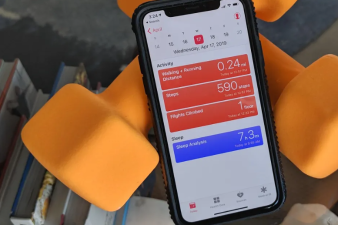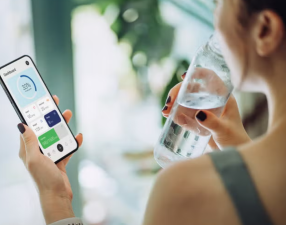Many people may only know about the iPhone Health App as a way to record the number of steps taken every day. However, the Health App can record far more data than you think, such as step length, breathing rate, resting heart rate, etc. The same is true for functions, including health tracking warnings, menstrual tracking, hearing protection, etc. Similarly, for those who have already purchased Apple Watch, it may be possible to play a real role and effect with the Apple Health App, not just message notifications and time.
Many people may only know about the iPhone Health App as a way to record the number of steps taken every day. However, the Health App can record far more data than you think, such as step length, breathing rate, resting heart rate, etc. The same is true for functions, including health tracking warnings, menstrual tracking, hearing protection, etc.
Similarly, for those who have already purchased Apple Watch, it may be possible to play a real role and effect with the Apple Health App, not just message notifications and time.

Introduction to the Health App and Basic Settings
The iPhone Health App has four main parts. The first part is the "Personal Center". Click the avatar on the right to enter the health details, medical emergency card, and the activation of functions and notifications.
In the health details, it is recommended to fill in the accurate age, gender, and whether there are any drugs that affect the heart rate. For example, aerobic fitness (the body's ability to inhale, circulate, and use oxygen) has different reference standards for different age groups and genders.
The medical emergency card is also a very important setting. The emergency contact can call the medical emergency card directly through the volume + button and the power button without unlocking the phone in an emergency; when wearing Apple Watch and encountering a serious fall, the "SOS Emergency Contact" will be automatically enabled and the emergency contact will be notified. If an accident occurs, the more emergency contacts (ex-partners) you add, the greater the possibility of rescue.
The "Summary" in the second part shows the health information and exercise information recorded by the Health App in different forms. These may include step length, foot support time, walking stability, breathing rate, etc. (some data require Apple Watch), which you usually don't care about. Therefore, in terms of health, the iPhone sometimes even requires you to know yourself better.
Below the summary and browsing in the fourth part, you can also see many different popular science articles, including sinus rhythm, blood oxygen level, gait stability and other knowledge.
The third part is "Sharing", in which you can view the health information shared to you by friends and family; similarly, you can also manage what data is included in the health information you share with others and whether to set health reminders. When some indicators exceed the standard value, the other party can learn about it in the notification of the Health App.
The function of the four-part "browse" is actually similar to the summary. Browsing is to classify health information according to different categories. Some health information (data) that cannot be obtained through software and hardware, such as nutritional intake, supports manual recording.
Different data sources of health app
There are four main sources of health data on the iPhone. One is information recorded by the iPhone's built-in sensors, such as steps, floors climbed, walking, sleep and other data.
The second category is data recorded by smart wearable devices, such as heart rate, aerobic fitness, health records, blood oxygen detected by Apple Watch, and environmental noise levels detected by AirPods or even third-party headphones. In general, Apple Watch is indispensable for obtaining relatively complete health data.
The third category is data recorded by third-party apps and devices. The last type is data that needs to be manually entered by individuals, such as height, weight, age, and other more complex historical symptoms, nutritional intake, etc.
After a preliminary understanding of the health app and the sources of different data, let's take a look at what Apple's health app can do after being equipped with some smart wearable devices (Apple Watch and Bluetooth headphones).

Record and track health status
Not only height and weight, but also health-related nutritional intake, medical history, or other health information you can think of can be manually recorded in the Health App to help you better understand your health status.
In addition, while recording the number of steps and distance every day, the iPhone will also evaluate whether there are potential health risks such as "asymmetric steps" based on the algorithm.
One function of Apple Watch may also be overlooked by most people, which is to detect environmental noise. Every Shenzhen person has a deep understanding of the specialty "clang clang clang, dongdongdong, bang bang bang" (a joke about construction noise). Through the detection of Apple Watch and the record of the iPhone Health App, we can understand whether we are in an environment with normal exposure (noise), and use noise-canceling headphones and earplugs when necessary.
Menstrual tracking
Whether it is a girlfriend or other female friends, most of them have the habit of recording their menstrual period through memos or third-party apps. In fact, Apple's Health App also provides similar functions.
Health sharing, real-time understanding of the health status of relatives and friends
One of the core functions of the iPhone Health App is actually the shared health data function updated in iOS 15. Starting from iOS 15, Apple's Health App has begun to support the selection of certain data to be shared with friends and family (to let the other party know whether you are still staying up late to check your phone at two or three in the middle of the night) to understand the exercise and health status of family and friends from time to time.
In addition, when sharing health information, you can set the corresponding health reminder function. For example, when Apple Watch detects recent sinus arrhythmia or an abnormally high or low heart rate, the other party can receive a health reminder.
SOS Emergency Contact
Another life-saving function in Apple Health, "SOS Emergency Contact", can be turned on manually or automatically triggered. For example, when Apple Watch (SE, 4th generation and above) detects that the fall is serious and seems unable to move, it will automatically enable contact with emergency services (120, 110, 119, etc.) and send a message to the emergency contact.

